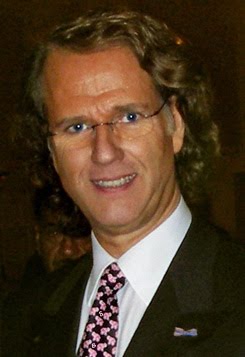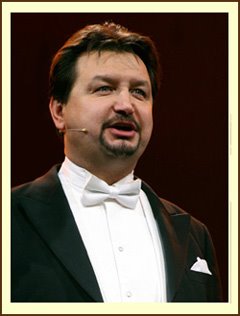André Rieu, waltz and all. An eccentric Dutch violinist has wowed thousands across Europe with his Strauss spectacles. The UK is next, he reveals.
April 1, The Times: I am sitting next to the stadium-conquering Dutch violinist André Rieu in a studio canteen. He is wearing a sharp three-piece suit, expensive Italian shoes — and a pink bib, tied around his waist with a ribbon. Rieu is working his way through a large bowl of spaghetti bolognese.
A young clarinettist approaches, dressed in a yellow satin crinoline and stands before him for approval. All the women in Rieu’s Johann Strauss Orchester are supplied with Queen Anne-style Sugarplum Fairy outfits for the stage. There are 27 females in his employ — roughly half the orchestra — but the sheer amount of material they wear gives the impression they vastly outnumber the men. “I like the dress,” he says, hoiking up her bosom an inch or two. “but the tits need to be higher."
Rising and removing his bib, Rieu — the waltz phenomenon, king of easy listening, “Mel Gibson of the fiddle” — cuts a magnetic figure at 6ft 3in, with a quick, flashing smile and a permanently raised eyebrow.
More Radio 2 than Classic FM, more James Last than Nigel Kennedy, the waltz phenomenon sits perfectly within the current revival of the Saturday night variety show, in all its glittery light relief. Last year Rieu outsold Bruce Springsteen and AC/DC on the Billboard Hot Tour rankings; his vast stadium shows have punters from Japan to Johannesburg twirling down the aisles in ecstasy. His new album, Forever Vienna, reached No 2 in the UK pop charts — repeat, the pop charts Schlagermusik, one critic called it — the stuff of bierfests and lederhosen.
But now it’s over here. Last week Rieu appeared on the final of the ITV show Dancing on Ice, playing Ravel’s Bolero for Torville and Dean. And tickets have just gone on sale for Rieu’s hugely ambitious UK tour, which takes in six huge venues and begins at the 20,000 capcity O2 Arena.
He certainly knows how to fill a space. Rieu’s live set comprises a life-sized reproduction of the Viennese Imperial Palace, two ice rinks, two fountains and a ballroom dancefloor. “They always said the Rolling Stones were the biggest show on Earth,” says Rieu’s tour manager Kerstin Cornelis. “But we beat them.” Not since Nigel Kennedy has there been such an ingenious exercise in classical music marketing.
Rieu has just gone platinum in the UK. “He assumed he was platinum anyway,” Cornelis says, whisking me into the Rieu residence in Maastricht — a 16th-century château with a vast Art Deco orangerie. We hurry through the kitchen where staff — gardeners, carpenters — are getting their elevenses; through the dining room where an oil painting of their master hangs on the wall.
“When André was a child he used to come to this castle for his piano lessons,” Cornelis explains. “He made a promise to himself that when he became famous he would come back and buy it.”
Now 60, Rieu has been making music for many years. He started playing the violin at 5 (his father was the conductor of the Maastricht Symphony Orchestra); at 28 he founded the Johann Strauss Orchestra and is credited with something they call “the waltz revival” in the late 1980s. Slowly but surely he cracked the overseas market, by force of his spectacular stage shows and mega-star self-marketing. André Rieu Productions has a yearly turnover of €55 million (£49 million).
“The unique feature is that we do everything ourselves,” says the company’s chief financial officer, Roel van Veggel. “Which means no external promoters, , managers, publicists.” Everything from catering to costume passes under the Rieu nose. “We control it all, in order to create the perfection André wants.”
Rieu is currently building a scale model of Maastricht town centre in time for his annual outdoor concert — “so that if it rains I can just move the town centre inside”, he explains. He openly models himself on Johann Strauss, the original Waltz King, who ran his brand of light music as a flourishing enterprise and acted like a rock star 100 years before rock stars were even thought of. Strauss was contracted to appear in several different Vienna concert halls every night, and he used to hurry between gigs in a hansom cab.
Tonight’s gig in Munich, with an audience of 10,000, is relatively small beer for someone who played to 38,000 one night in Melbourne last year. “It’s hugely encouraging to see core classical repertoire, performed by a professional orchestra, resonate with such a large audience,” says Sam Jackson, the executive producer of Classic FM. “We’re hoping that the resurgence in enthusiasm for Strauss waltzes leads people to discover a wealth of other classical music.”
The touring machine unfolds with clockwork precision: 4pm, soundcheck; 6pm, dinner; 6.30pm, powernap until 7.15pm. This is a man with a mania for punctuality: any audience member late for the second half, slipping back to their seat with a bratwurst or lager, is caught on camera and shown on one of the stage monitors while the brass section improvsises slapstick tunes to accompany the “walk of shame”.
On stage Rieu plays and conducts simultaneously — just as Strauss used to do — and minutes into the waltz-heavy first half a low hum emanates from the crowd as 10,000 heads sway in time. Soon we’re moving away from “mainstream classical” and into pop and show-tunes — Michael Jackson’s Earth Song, Y Viva España and Seventy-Six Trombones. Children from a local school perform a flawless dance routine.
A comical, high-energy show begins to emerge, full of carefully choreographed little farces — a man “vomiting” into someone else’s tuba, another balancing a trombone on his chin — and then, with the auditorium bathed in blue light, it’s time for The Blue Danube. People slip out of their seats to waltz up and down the aisles. Rieu tips an imaginary top hat to the crowd and closes the show with Brahms’s Lullaby, “falling asleep” on his violin against a backdrop of a thousand stars. The stadium is filed with a strange, communal, tingly warmth.
“Can you feel it?” he says on the tour bus after the show as we speed towards the Munich Hilton. I realise that my chair is moving: Rieu is manipulating me, slowly — up and down, back and forth — via a small transmitter in his pocket. “I am controlling you!” he laughs.
On my left is his latest protégée, a 24-year-old Australian soprano called Mirusia Louwerse and, just across the aisle, her predecessor, the 30-year-old Carmen Monarcha from Brazil. Both smile sweetly. It can't be easy for them, far from home, in thrall to the Svengali of the strings day in and day out.
Britain remains the last territory unconquered by the Rieu live show, but all that is about to change. “For André’s audience seeing is believing,” says Mark Wilkinson of Rieu’s recording company, Decca. “These are older consumers, passive music buyers, but when they hear something they like, they have to have it.”
A 20,000-seat venue for a man that most people in the UK haven’t actually heard of yet? He ought to aim a bit higher ... Kate Mossman



































































































































No comments:
Post a Comment